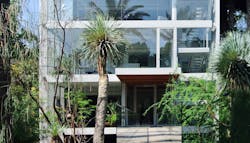Owner’s Rep: Miró Rivera Architects, Austin, Texas
*Architect: Miró Rivera Architects, Austin, Texas
*Structural Engineer: Datum Engineers, Austin, Texas
General Contractor: Withheld at Owner’s Request
*Firms that co-entered the project in the IDEAS2 contest
Located on one of the highest sites in Dallas – minutes away from downtown, the vertical volume of the five-story residence rises 58 feet above the surrounding landscape, rotated from the adjacent neighborhood grid to capture views of the picturesque downtown skyline. The compact footprint of the project is sectionally integrated into the site via a carved spiraling entry drive which allows for an almost subterranean experience of the existing natural canopy, while the verticality of the two exterior screen walls accents the home’s slenderness and height. This curvilinear geometry emanates from the master suite and extends out into the landscape. Visitors to the house arrive at natural grade and then cross over the excavated area via an internally stabilized architecturally exposed structural steel (AESS) foot bridge to the front entry. The 4-ft-wide foot bridge is framed with a pair of C15x50 edge stringers, each spanning 43 feet. Vertical & horizontal diaphragm X-rod bracing is provided in panel bays of 4-foot, 3½-inches, with a steel grating floor accented by thin strips of glass flooring on the edges.
The house is conceived as two interlocking oppositional volumes: one highly transparent and oriented toward distant views and one solid and oriented towards the site. The taut transparent volume is delicately flanked at either end by a vertical steel screen of HSS6x2 AESS columns spaced at 6 inches on center, which simultaneously and elegantly shades and structurally supports this portion of the house.
The tight floor-to-floor requirements of the project required a close integration of the various building systems, without compromising, and preserving, the structural integrity and preserving the architectural expression. The interior elevated floor framing consists of a series of very shallow depth wide-flange beams with shear studs, supporting a 1½-in.-deep composite metal deck filled with 2¾-in. concrete above the deck flutes. Wide-flange floor framing ranges in size from W10x17 to W10x100.
Each wide-flange beam is connected via welded moment connections to a stiff C15x50 steel channel along the perimeter walls, which distributes the vertical loads from the conventionally spaced interior beams to the closely spaced exterior screen columns. The steel Hollow Structural Section (HSS) curtain, which provides vertical support for the floors, is set 1-foot, 4-inches clear of the floor edge. This visual break between the floor and supporting screen of columns was critical to the architectural effect. Each screen column, positioned proud of the exterior walls, is connected to the perimeter channel via a vertical ¾-in.-thick steel plate at each floor level; each plate not only transmits the dead and live loads to the columns, but also provides the required stability bracing against weak axis flexural buckling of each 58-ft-tall screen column, via weak axis bending of the cantilevered plate. The stresses in the connection system were relatively small when compared to the nominal capacities, as the structural design of each plate was materially governed by the flexural stiffness requirements for nodal bracing.
The solid volume, clad in locally abundant limestone, is tectonically differentiated from its butt-glazed counterpart with inset windows providing a pronounced shadow line at penetrations. A glass & AESS “floating stair,” along with an adjacent elevator core, provide the primary vertical circulation of the residence. The AESS stair is comprised of 1” x 4” steel plate stringers oriented in a “zigzag” geometry that follows the pattern of the AESS tread and riser plates. The stair terminates at an inviting fifth level open-air roof terrace which provides breathtaking 360-degree views of Big D; the terrace is shaded from the afternoon sun by an extension of the HSS6x2 screen columns, which folds at the roof level to form a horizontal roof trellis. The intermediate stair landings are cleverly suspended via two disguised thin steel rods; each rod hangs from the screen-turned-trellis, created a “floating stair” aesthetic. Captured rain water from the roof well is used throughout the site as supplement to surrounding landscaping.
